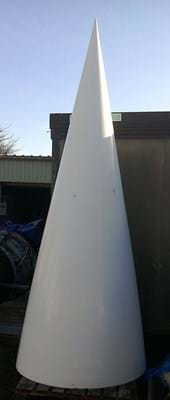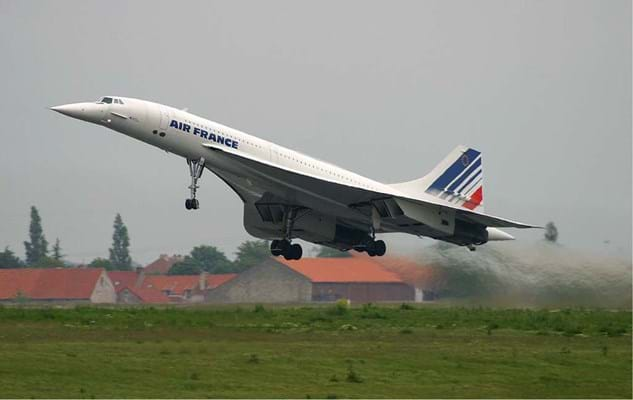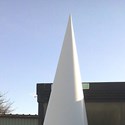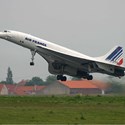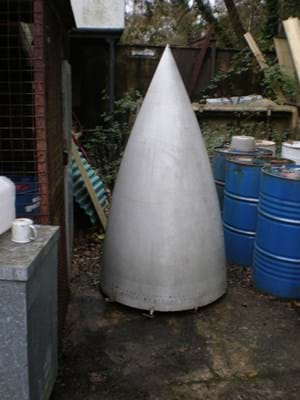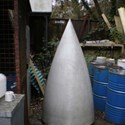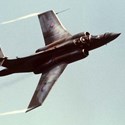Last summer JP Humbert offered the bomb release button from the Lancaster bomber of 617 Squadron that unleashed the ‘bouncing bomb’ which destroyed the Möhne Dam on May 17, 1943, but it is a more recent innovation in focus this time.
The auction house – now known as Humbert & Ellis – has estimated this original Concorde nose cone dating to the 1970s at £45,000-60,000 in its February 22 auction near Silverstone in Northamptonshire.
Rare by definition, this is thought to be the only unused nose cone from the few that were originally made for the Concorde fleet by BAC Aerospatial.
Standing 3.3m (11ft) high on a 4ft 6in (1.35m) diameter base, the cone enabled the aircraft to achieve supersonic flight and make a flight time of just of 3.5 hours possible between Paris and New York.
The cone, which was a key feature of the 'droop nose’ Concorde design, is offered at auction for the first time.
Auctioneer Jonathan Humbert said: “We appreciate this is not an inexpensive item but I’d be hard-pressed to think of a more exclusive and iconic item to sell than a famous nose cone from the world’s fastest commercial plane.”
Concorde was the first supersonic passenger-carrying commercial aeroplane and was built jointly by aircraft manufacturers in the UK and France. Its first transatlantic crossing was on September 26, 1973. The world’s first scheduled supersonic passenger service followed on January 21, 1976—British Airways flying from London to Bahrain and Air France from Paris to Rio de Janeiro.
The glamorous world of Concorde was only affordable to a few, however, and huge operating expenses meant New York became the only regular service. Concorde commercial flights ended in 2003, at which point just 14 had gone into service – and the image of Concorde had also been shaped by the tragedy of July 2000, when Air France Flight 4590 crashed on take-off, causing 113 deaths (although this was the only fatal accident in 27 years of operation).
Buccaneer spirit
If the hefty Concorde nose cone estimate doesn’t suit the depths of your pockets, then another nose cone for a classic British aircraft is estimated at £1500-2500 in the same sale.
It is an original Hawker Siddeley Buccaneer (first known as the Blackburn Buccaneer) fighter jet nose cone, 1.7m (5ft 7in) in height with 95cm (3ft 1in) diameter base, constructed from alloy and composite, produced c.1974.
The Buccaneer was a mid-wing, twin-engined monoplane with a crew of two. It was regularly required to fly at sea level to avoid radar and enemy defence systems and flew from both aircraft carriers and shore bases. The Buccaneer was one of the largest aircraft to operate from British aircraft carriers.
According to baesystems.com: “The Blackburn NA39 was a rugged carrier-borne high speed low-level strike aircraft and in its production form it became famous as the Buccaneer. The NA39 prototype (XK486) was first flown at RAE Bedford on April 30, 1958, piloted by Derek Whitehead.
“Blackburn & General Aircraft were later absorbed into Hawker Siddeley Aviation Ltd (HSAL) during 1960 but the company continued to trade under its original identity until on July 1, 1963, a divisional structure was created and Blackburn became the Hawker Blackburn Division - from that date onward all Blackburn products were styled as ‘Hawker Siddeley’ types rather than under the name of their original parent firm.”
After Royal Navy service, the Buccaneers entered the Royal Air Force. The latest SMk 2Bs type, equipped with laser designation equipment for Paveway laser-guided bombs, served with distinction in the First Gulf War in 1991.
The last Buccaneers were withdrawn from RAF service in 1994.


